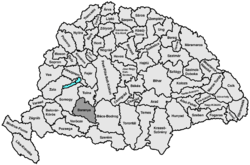Baranya County (historical)
|
Baranya County (Branau) (1910) |
|
|---|---|

|
|
| Administrative headquarters : | Pécs |
| Area : | 5,177 km² |
| Population : | 352.478 |
| Ethnic groups : | 57% Magyars 32% Germans 4% Serbs 3% Croats 4% others |

|
|
The Baranya (German rarely County Baranya ; Hungarian vármegye Baranya , Croatian Baranja , Latin Comitatus Baraniensis ) was a historic administrative unit ( county or county ) in the Kingdom of Hungary .
Most of the area is in present-day Hungary (there in Baranya County ), a smaller part in the south belongs to present-day Croatia (as part of Osijek-Baranja County ).
location
The county bordered Somogy , Tolna , Bács-Bodrog and Virovititz ( Verőce ) counties . It lay between the Drava in the south and the Danube in the east.
history
The county emerged relatively early in the 11th century. At that time it reached as far as the Save in today's Slavonia . Some of the Slavonian areas were already lost in the Middle Ages through the establishment of other counties ( Požega and others) or territorial cedings (especially to Vukovar county ). The rulership structure of the Baranya was characterized by a strong small and middle nobility in the Middle Ages . Magnates like the Garai family and church princes ( Diocese of Fünfkirchen and Abbey of Pécsvárad there were only a few. Between 1526 and 1566, Baranya came into the possession of the Ottoman Empire through conquest . During the Turkish rule over the area it belonged to Sanjak Mohács. The Hungarian county organization Only after the reconquest by the Habsburg Empire in 1686/1687 was it re-established as a county, this time without the Slavonian parts. Under Habsburg rule, the system of manorial power was changed significantly compared to the pre-Turkish period. Baranya was now a land of large estates , in which Habsburg followers from outside the county dominated the manors. Serbian troops occupied the area after the end of World War I in 1918. Until the Treaty of Trianon , it was administered by the Kingdom of Serbs, Croats and Slovenes and then divided between Hungary and the Kingdom Hungary would remain A part of it remained within its boundaries until the major county reform in 1950, when the area around the town of Szigetvár was taken over by Somogy county . See also under Baranya County .
Origin of the name Baranya
Croatian Baranja stands for Baranya vármegye (county) in Hungarian. The name goes back to the Baranyavár Castle (formerly: Castrum Borona). The origin of Borona suggests Slavic origins. (Compare the Montenegrin town of Borenjina). The Magyars usually replace the Slavic "o" with the Hungarian a, which is pronounced similarly.
District subdivision
In the early 20th century the following chair districts existed (mostly named after the name of the administrative seat):
| Chair districts (járások) | |
|---|---|
| Chair district | Administrative headquarters |
| Baranyavár, today Branjin | Dárda today Darda |
| Hegyhát | Sásd |
| Mohács | Mohács |
| Pécs | Pécs |
| Pécsvárad | Pécsvárad |
| Siklós | Siklós |
| Szentlőrinc | Szentlőrinc |
| City district (törvényhatósági jogú város) | |
| Pécs | |
The municipality of Darda is in today's Croatia, all other places in today's Hungary .
See also
Web links
- Entry on the county in Meyers Konversationslexikon from 1888
- Entry in the Pallas Lexicon (Hungarian)
swell
- ↑ A magyar szent corona országainak 1910. évi népszámlálása . Budapest 1912, p. 12 ff.
- ↑ A magyar szent corona országainak 1910. évi népszámlálása . Budapest 1912, p. 22 ff. (1910 census)
- ↑ Baranya County is not to be confused with the Upper Austrian city of Braunau . Anton Tafferner (born 1910) tried unsuccessfully in the 1920s to Germanize the name Baranya as "Branau". Only the name Baranya was commonly used.
- ^ Anton Scherer : Suevia-Pannonica . Graz 2009, p. 15 .
- József Andretzky: Baranyavármegye nemesei (The Nobles of Baranya County). Pécs 1909.
- Claus Heinrich Gattermann: The Baranya in the years 1686 to 1713. Continuity and change in a Hungarian county after the departure of the Turks . Universitätsverlag Göttingen, Göttingen 2005, ISBN 3-938616-32-6 .
- Frigyes Pesty : Az eltünt régi vármegyek (The vanished old counties). Budapest 1880 (reprinted Budapest 1988).
- István Taba: Baranya megye népessége a XVII. század végen (The population of Baranya county at the end of the 17th century). Pécs 1941.
- Ferenc Várady: Baranya múltja és jelenje (past and present in Baranya). 2 volumes, Pécs 1897.
- D. Csaba Veress: Várak Baranyában (Castles in the Baranya). Budapest 1992.

